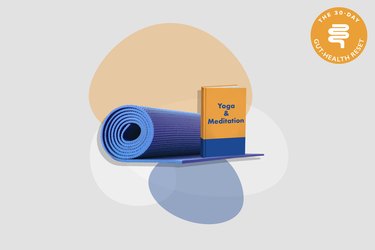
We live in a sped-up world that makes multitasking seem normal, or even preferred. Case in point: Many of us eat our meals while doing something else (scrolling through Instagram, answering emails, watching Netflix). But this high-stress, distracted lifestyle can be tough on our digestive systems.
"When you eat at your desk in five minutes, you're in a stressed-out state. You can't digest well in that state," Vincent Pedre, MD, author of Happy Gut and creator of the 28-Day Happy Gut Cleanse and Happy Gut app, tells LIVESTRONG.com.
For the sake of restoring — and maintaining — good gut health, Week 4 of our 30-Day Gut-Health Reset is all about slowing things down. That means taking your time to eat, cutting down on stress and fitting healthy movement into your day-to-day.
Your Goals for Week 4
- Practice mindful eating
- Prioritize stress relief
- Add yoga to your routine
- Continue using your gut-health tracker from Week 1
New to the challenge? Click here to get all the details on the 30-day program.
Goal 1: Practice Mindful Eating
Multitasking during meals can lead to overeating, according to a February 2013 review in the American Journal of Clinical Nutrition. In contrast, mindful eating — or using all your senses as you eat and being in the moment with your food — might help curb it or even encourage healthier choices at mealtime, according to Harvard Health Publishing.
"You need to rest to digest," Dr. Pedre says. "In other words, you need to give your gut space by slowing down in order to digest better."
Get started with mindful eating this week with these tips:
- Pause before you eat. Ask yourself why you're eating before you dig in, according to the Mayo Clinic. (Reminder: Don't eat because you're bored.)
- Chew slowly. Once you start eating, make sure to actually chew each bite thoroughly. "Don't gulp your food down in seconds. People forget that digestion begins in the mouth," Dr. Pedre says.
- Engage your senses. Eating is a multisensory experience, Dr. Pedre says — so take time to look at your plate and to smell and taste your food. Doing so might also help you feel calmer, which is also good for digestion, he says.
Goal 2: Prioritize Stress Relief
If you've ever "gone with your gut," had butterflies in your stomach or experienced a gut-wrenching emotion, that's thanks to the gut-brain connection — the chemical link between your intestinal tract and brain that allows one to affect the function of the other.
More specifically, stress and anxiety have been linked to GI symptoms, including abdominal pain, bloating, nausea, diarrhea and constipation, according to the Cleveland Clinic. In turn, those gut symptoms can affect your mental and emotional wellbeing — leading to a vicious cycle of mental and physical ailments.
"We're wired to shut down the gut in a stressed state," Dr. Pedre says. If you're under constant pressure, it's quite likely your gut won't function properly. Think about it: When your body is in fight-or-flight mode, that's no time to have a bowel movement, he says.
If your days are always jam-packed and you frequently find yourself feeling overwhelmed or anxious, developing coping tactics to dial down your stress levels is a must.
- Keep a gratitude journal. Take steps to focus on the positive and the small wins, Dr. Pedre says. He recommends writing down something you're grateful for each day.
- Spend time with friends. Don't neglect close friendships. Make time to talk to friends that goes beyond text messages to either online video chats or in-person get-togethers whenever possible. Friendship is good for your overall health and helps to curb stress, according to the Mayo Clinic.
- Focus on you. Carve out time for yourself, Dr. Pedre says. Instead of mindlessly munching while responding to emails, for instance, take a real lunch break — sans electronics. Use it to walk outside or eat in the kitchen, away from any work-related technology.
- Practice mindfulness. Being in the moment can ease stress, per the National Institutes of Health. For a simple do-anywhere meditation exercise, take a few moments to sit comfortably and focus on your breath (in, out, in, out), according to the Mayo Clinic.
Goal 3: Add Yoga to Your Routine
Like we discovered in Week 3, yoga is good for your gut because it can help alleviate constipation, Dr. Pedre notes. All that bending, twisting and stretching helps the stomach and intestines "move things along," so to speak.
But practicing yoga is also another smart stress-management strategy, notes the U.S. National Library of Medicine.
Here are a few simple, effective poses to get you started, courtesy of Dr. Pedre and yoga instructor Shawna Davis.
Move 1: Cat-Cow
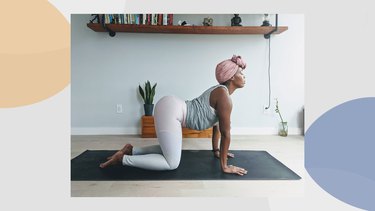
- Start on your hands and knees with your shoulders above your hands and your knees directly under your hips.
- As you inhale, lift your sitting bones and chest toward the ceiling, allowing your belly to sink toward the floor and your head to look straight forward.
- As you exhale, round your spine toward the ceiling and release your head toward the floor.
- Repeat five times.
Move 2: Supine Twist

- Lie on your back with legs extended, feet flat on the floor and arms spread in a "T" shape.
- Exhale and bring your right knee to your chest.
- As you inhale, allow your right knee to fall to the left, keeping your right shoulder on the ground and turning your head to the right. To deepen the stretch, you can press gently on your right knee with your left hand.
- Take five deep breaths, then return to the starting position.
- Repeat on the opposite side.
- Repeat three times on each side.
Move 3: Bridge
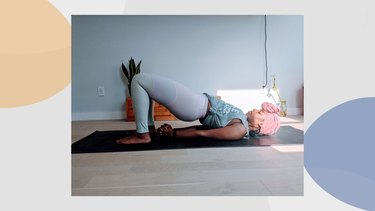
- Lie on your back with knees bent, feet flat on the floor and arms parallel to your body.
- Pressing your feet and arms into the ground, inhale and lift your back, extending the tailbone away from the chest while lifting the hips up to the sky.
- Roll your shoulders back and underneath the chest, squeezing the blades together and pressing the forearms into the floor. Clasp your hands under your lower back if it feels comfortable for you.
- Take three deep breaths, then exhale and lower to the starting position.
- Repeat three times.
Move 4: Forward Fold
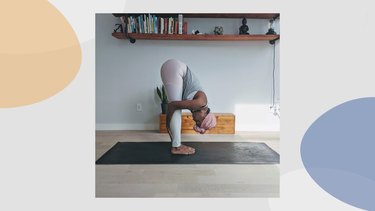
- Start standing tall.
- As you inhale, reach your arms up, lengthening your spine and torso.
- As you exhale, bend forward from the hips and extend your body over your legs, reaching for your toes, ankles or shins.
- Hold for five breaths, then release by slowly rolling back up to a standing position.
- Repeat five times.
Move 5: Downward Facing Dog
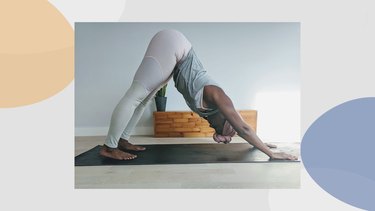
- Begin on your hands and knees.
- As you inhale, curl your toes and lift your knees off the ground.
- Exhale, straighten the legs and bring the hips to the sky, flattening the feet. Allow your head to dangle.
- Stay here for several breaths, then gently bend the knees and return to starting position.
- Repeat three times.
Move 6: Triangle Pose
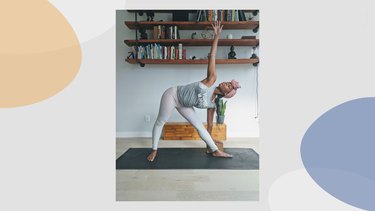
- From a standing position, place your feet in a wide, staggered stance.
- Align your heels, with your front foot pointing forward and your back foot turned at a 45-degree angle.
- Inhale and lift your arms to shoulder height, parallel to the floor, directly over your legs.
- Exhale and reach your front hand forward, pulling your torso forward and aligned over the front leg, chest to the side.
- Lower your front hand to your front leg, shin or ankle or a yoga block.
- Inhale and reach your back hand up toward the sky as you look toward that hand.
- Exhale and lengthen your tailbone to your back heel.
- Hold for five breaths.
- Repeat on the other side.
Your Takeaways for Week 4
For the sake of your health, slow things down. Take time to eat, appreciating every bite. Don’t chow down with a phone in your hand or a keyboard at your fingertips. Plus, prioritize stress-relieving tactics and incorporate yoga into your movement routine. These strategies are helpful for your overall health but are particularly important when it comes to your gut, since stress can lead to an array of unpleasant symptoms.
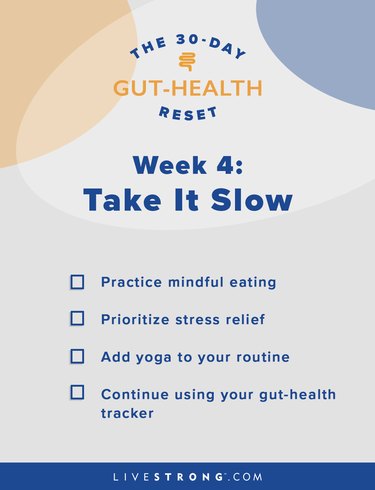
Click here for a printer-friendly version of this week's plan!
Is this an emergency? If you are experiencing serious medical symptoms, please see the National Library of Medicine’s list of signs you need emergency medical attention or call 911.